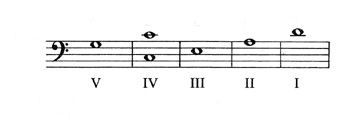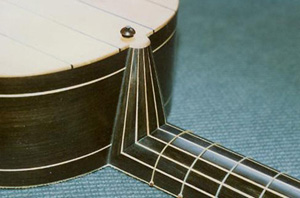One baroque guitar tuning replicates the modern day
guitar with it's uninterrupted descent from high-to low sounding
strings.
Another option for a lighter texture, the bass sonorities
are replaced by high pitched treble strings. The pitches descend
from e' to b' to g (like the modern guitar), but then leap up
to a treble d', and a' - thus making the third course the lowest
sounding note. This is called re-entrant
tunning since the treble sounds first and later 're enters'
as one strums across the instrument.
ITALIAN
TUNING: G-C-E-A-D

Another tuning splits the fourth and fifth courses
into actaves (one treble and bass string on each).
The one most favored by the French emplys an octave
split on the fourth course and a pair of unison treble strings
on the fifth course. For this tuning, the lowest sounding voice
is bass d on fourth course.
FRENCH TUNING: G-C-F-A-D

One last tuning is splitting the third course into
actaves: the highest sounding g' soars above the rest.
Tuning Affecting Interpretation
Robert de Visée and Nicolas
Derosier prescribe what fingers to use to produce any given
gesture, and they are attuned to the subtle distinctions caused
by the different size fingers and different timbres produced
by the fingernails and the fingertips. Visée is keenly aware of the tuning and carefully arranges the
fingerings to bring out the proper octave of a course. When the
bass string dominates, he has the index finger strike in an upward
direction, bringing out the bordón. If he wants the treble
to sound louder, he selects the thumb- for greater force.
Other artists such as Murcia employ a percussive golpe
on his lively settings of Afro-American cumbés. Murcia and Sanz also employ the campanella, bell like effect,
resulting from the five courses sounding in the same octave
which facilitiates the playing of scales in stepewise motion by
merely changing strings.
For the baroque guitarist an elegant musical phrase should
be rich in nuanced timbres, each note and chord having its own
color and articulation. This is in opposition to the Classical
aesthetic where consistency of timbre was the desirable goal. |




